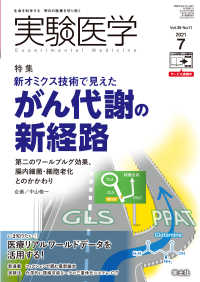- ホーム
- > 洋書
- > ドイツ書
- > Mathematics, Sciences & Technology
- > Biology
- > popular works
Full Description
This book guides its audience—which can range from novice users to experts— though a 55-chapter tour of Google Earth Engine. A sequenced and diverse set of lab materials, this is the product of more than a year of effort from more than a hundred individuals, collecting new exercises from professors, undergraduates, master's students, PhD students, postdocs, and independent consultants.
Cloud Based Remote Sensing with Google Earth Engine is broadly organized into two halves. The first half, Fundamentals, is a set of 31 labs designed to take the reader from being a complete Earth Engine novice to being a quite advanced user. The second half, Applications, presents a tour of the world of Earth Engine across 24 chapters, showing how it is used in a very wide variety of settings that rely on remote-sensing data This is an open access book.
Contents
Part 1: Programming and Remote Sensing Basics.- 1. JavaScript and the Earth Engine API.- 2. Exploring Images.- 3. Survey of Raster Datasets.- 4. The Remote Sensing Vocabulary.-Part 2: Interpreting Images.- 5. Image Manipulation: Bands, Arithmetic, Thresholds, and Masks.- 6. Interpreting an Image: Classification.- 7. Accuracy Assessment: Quantifying Classification Quality.- Part 3: Advanced Image Processing.- 8. Interpreting an Image: Regression.- 9. Advanced Pixel-based Image Transformation.- 10. Neighborhood-based Image Transformation.- 11. Object-based Image Analysis.- Part 4: Interpreting Image Series.- 12. Filter, Map, Reduce.- 13. Exploring Image Collections.- 14. Aggregating Images for Time Series.- 15. Clouds and Image Compositing.- 16. Change Detection.- 17. Interpreting Annual Time Series with LandTrendr.- 18. Fitting Functions to Time Series.-19. Interpreting Time Series with CCDC.- 20. Data Fusion: Merging Classification Streams.- 21. Exploring Lagged Effects in Time Series.- Part 5: Vectors and Tables.- 22. Exploring Vectors.- 23. Raster/Vector Conversions.- 24. Zonal Statistics.- 25. Advanced Vector Operations.- 26. GEEDiT - Digitizing From Satellite Imagery.- Part 6: Advanced Topics.- 27. Advanced Raster Visualization.- 28. Collaborating in Earth Engine with Scripts and Assets.- 29. Scaling up in Earth Engine.- 30. Sharing Work in Earth Engine: Basic UI and Apps.- 31. Combining R and Earth Engine.- Part 7: Human Applications.- 32. Agricultural Environments.- 33. Urban Environments.- 34. Built Environments.- 35. Air pollution and population exposure.- 36. Heat Islands.- 37. Health Applications.- 38. Humanitarian Applications.- 39. Monitoring Gold Mining Activity using SAR.- Part 8: Aquatic and Hydrological Applications.- 40. Groundwater monitoring with GRACE.- 41. Benthic Habitats.- 42. Surface Water Mapping.- 43. River morphology.- 44. Water Balance and Drought.- 45. Defining Seasonality: First Date of No Snow.-Part 9: Terrestrial Applications.- 46. Active fire monitoring.- 47. Mangroves.- 48. Mangroves II - Change Mapping.- 49. Forest Degradation and Deforestation.- 50. Deforestation Viewed from Multiple Sensors.- 51. Working With GPS & Weather Data.- 52. Creating Presence and Absence Points.- 53. Detecting Land Cover Change in Rangelands.- 54. Conservation I - Assessing the spatial relationship between burned area and precipitation.- 55. Conservation II - Assessing Agricultural Intensification Near Protected Areas.







